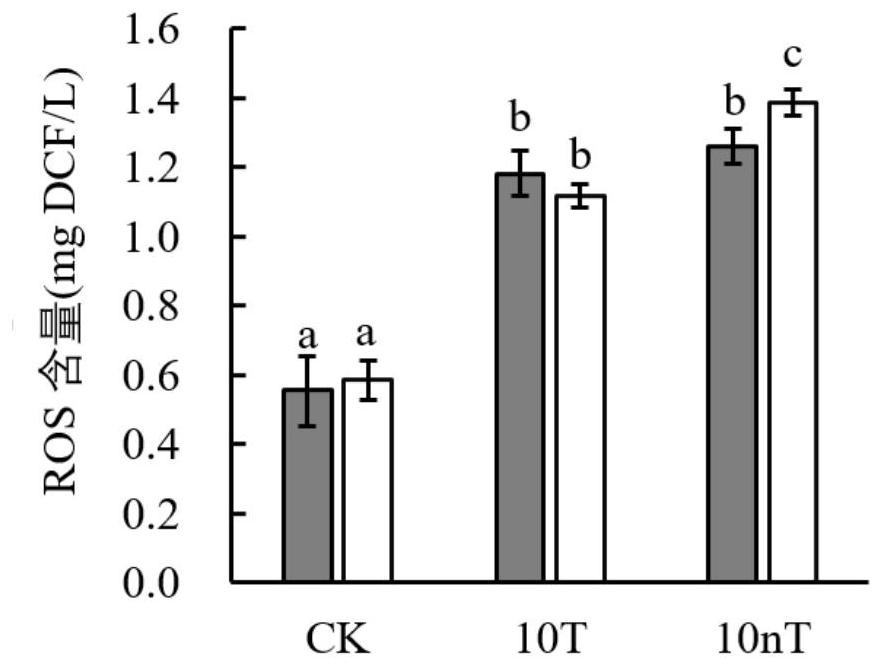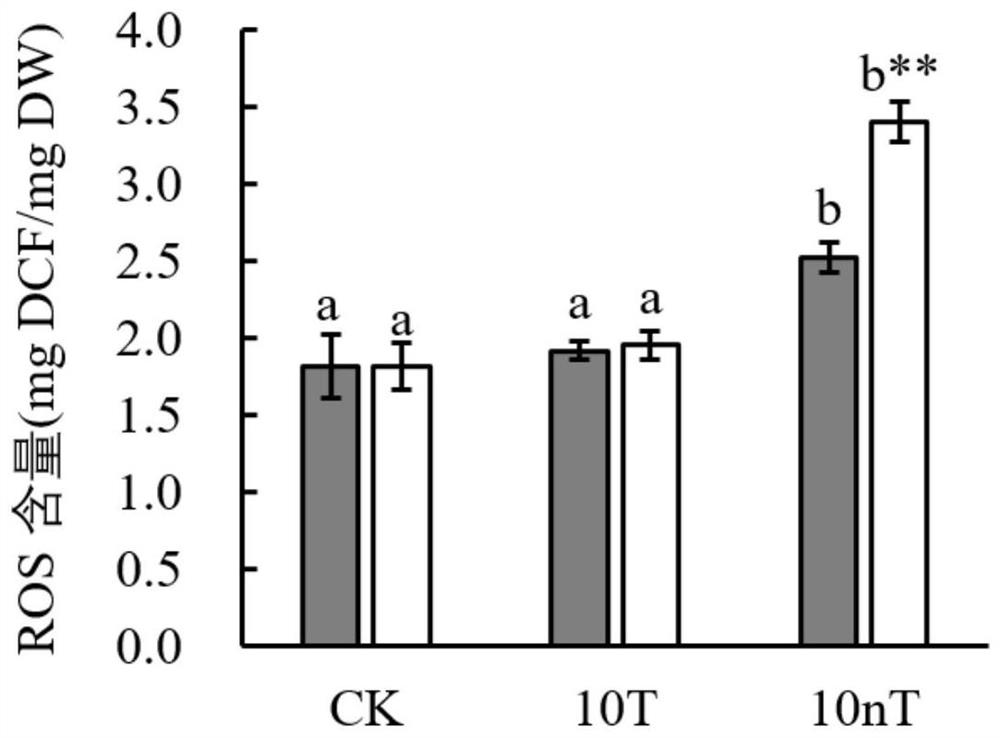Method for Quantitative Determination of In Vitro/In Vitro Superoxide Radical Content Generated by Environmental Stress
A quantitative determination and free radical technology, applied in the field of environmental toxicology, can solve the problems of signal loss, inability to distinguish fluorescence, and inability to directly compare the results, so as to reduce the interference of external environmental factors, and the method is simple and reliable.
- Summary
- Abstract
- Description
- Claims
- Application Information
AI Technical Summary
Problems solved by technology
Method used
Image
Examples
Embodiment 1
[0058] Validation experiments for the determination of superoxide radical content in vitro by the above method.
[0059] Take 0.05 g of nano-titanium dioxide (nTiO 2 ) or large particles of titanium dioxide were dissolved in 500 mL of EPA medium, and the JP-060ST ultrasonic cleaner was used for 30 min (360 W, 50 kHz) in a water bath at 43 °C under the conditions of good dispersion, moderate thermal motion of particles, and no coagulation. , Jiemeng, Shenzhen, China), formulated with 100 mg / L TiO 2 The mother liquid medium needs to be prepared now to reduce the coagulation of titanium dioxide due to its own thermal motion.
[0060] Under the protection of nitrogen gas, accurately weigh 1 mg of 2,7-dichlorodihydrofluorescein into a 1.5 mL centrifuge tube, add 1 mL of methanol solution, vortex to dissolve, and prepare a 1 g / L solution. After observing that there are no solid particles remaining, filter it with a 0.22 μm needle filter and use it as the 2,7-dichlorodihydrofluores...
Embodiment 2
[0064] A method for quantitatively measuring ROS content in rotifers, specifically including the following experimental contents:
[0065] (1) Preparation of 1 mM working solution:
[0066] Accurately weigh 0.0487g of 2,7-dichlorofluorescein diacetate (H2DCFDA) into a 15mL centrifuge tube, use an appropriate amount of dimethyl sulfoxide to prepare a stock solution with a concentration of 10 mM, and then use EPA buffer to dilute to 1 The working solution with mM concentration was dispensed into 1.5mL centrifuge tubes and stored at -20°C.
[0067] H2DCFDA is a highly efficient bioaffinity fluorescent probe. As a non-polar compound, it can quickly diffuse into cells, be hydrolyzed into dichlorodihydrofluorescein under the action of cellular esterase, and react with ROS in cells to generate fluorescence The substance dichlorofluorescein fully excludes the interference of ROS in vitro.
[0068] 3.3.2 Experimental procedure
[0069] The experimental settings were 1 mg / L, 10 mg / L ...
Embodiment 3
[0076] Validation experiment for measuring the content of superoxide radicals produced in hydrogen peroxide by the method of Example 1.
[0077] Use distilled water to configure hydrogen peroxide to two mass percentage concentrations of 0.1% and 1%, and prepare a distilled water sample as a control.
[0078] Under nitrogen protection, accurately weigh 1 mg of 2,7-dichlorodihydrofluorescein into a 1.5 mL centrifuge tube, add 1 mL of methanol solution, vortex to dissolve, and prepare a 1 g / L solution. After observing under a microscope that no solid particles remain, filter it with a 0.22 μm needle filter and use it as a 2,7-dichlorodihydrofluorescein stock solution. To exclude the interference of oxygen in the air, the 2,7-dichlorodihydrofluorescein solution should avoid exposure to air.
[0079] Take 10 ml of 0.1%, 1% mass percentage of hydrogen peroxide and control group liquid and add them to three beakers respectively, add 50 mL of the above-treated EPA medium to each beak...
PUM
| Property | Measurement | Unit |
|---|---|---|
| diameter | aaaaa | aaaaa |
| length | aaaaa | aaaaa |
| particle diameter | aaaaa | aaaaa |
Abstract
Description
Claims
Application Information
 Login to View More
Login to View More - R&D
- Intellectual Property
- Life Sciences
- Materials
- Tech Scout
- Unparalleled Data Quality
- Higher Quality Content
- 60% Fewer Hallucinations
Browse by: Latest US Patents, China's latest patents, Technical Efficacy Thesaurus, Application Domain, Technology Topic, Popular Technical Reports.
© 2025 PatSnap. All rights reserved.Legal|Privacy policy|Modern Slavery Act Transparency Statement|Sitemap|About US| Contact US: help@patsnap.com



